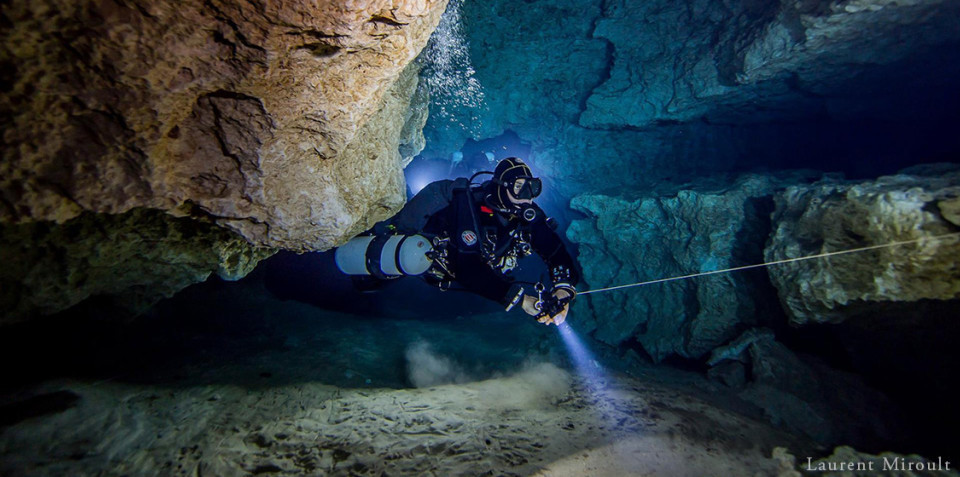[leadin]The world’s cave diving mecca is one thing I definitely did not expect to find in Florida.[/leadin]
The “Sunshine State” is known for its yachting, fishing, snorkeling and scuba diving. Inland, people associate water with swamps full of crocodiles and only traversable by airboat. But did you know Florida has one of the largest systems of freshwater caves in the world?
“Florida is like Swiss Cheese,” was how it was described to me. It has the longest known underwater system in the United States that spans two counties, with multiple entrances called sinks.
It is the perfect environment for cave systems. Florida is not located near any tectonic plates so it has the least earthquakes out of any state, tied with North Dakota. This means any fragile geological structures are preserved. The Florida plateau is also composed of a type of stone called karst limestone that water easily erodes into channels. In addition, because the Everglades are essentially a large slow-flowing river, these systems have not collapsed because they remained submerged despite lower water levels during warmer climate periods in the earth’s history.
Springs are categorized by the volume of water they discharge, with first magnitude being the largest at 740 gal/m (2,800 L/m). Florida has 27 known first magnitude springs and that has caused the community to develop new technology and skills to navigate such forceful flows.
As recently as 2007 one such flow called the Weeki Wachee Spring was so powerful that it was not until a severe drought slowed the flow down enough so that divers from the Karst Underwater Research reached a depth of 400 ft. In fact, the sport is so raw that almost everyone I met was working on their own personal exploration projects, as the first people to map a network out get to name it.
Cave diving is a disorientingly freeing experience. I had a chance to dive down and just barely peek into one of the systems as you have to be trained to enter. I will absolutely admit that it left me breathless, no pun intended. The experience was totally abstract in that it opened up another dimension of movement to me. I was no longer walking on a plane (forward and backward, left and right, and rotating), but I was moving through space in three dimensions. I had to control my buoyancy in a delicate balance to “float” and making sure not to tip or rotate. All this with a garage of equipment strapped to me; tanks, vests, flippers, wetsuit, mask, tubes everywhere! And if you are not gentle and kick too hard, you immediately lose all vision with all the silt you kick up.
I felt like I was an astronaut exploring an environment out of a science fiction movie. We were gently floating around weightless with strange creatures and alien plants. There were platter sized turtles, colorful fish, tiny insects and crustaceans, and other animals I couldn’t identify; all watching these clumsy intruders into their world. We had bright colored beams; flashlight sabers that sliced the water and caused plants to glow like fiber optic cables. Every surface seemed to be alive and there was no direction as I lost track several times, watching the bubbles escape for indication of where was up. A muted world where sounds were amplified and muffled at the same time. And when I peered into the caves, a network of unknown size, shape, and depth; a portal to a frontier accessible to anyone who can reach Florida.
But it is dangerous, very dangerous. A disclaimer must be made that cave diving is the most technical type of diving and requires patience, caution, and carefully graded training. There is complex equipment that can fail and you’re carrying backups of backups, even on simple dives. Environmental variables change rapidly: pressure increases at 1 unit at sea level every 33 feet or enough to pop your ears every 10 feet, flow can be extreme and push or suck you unexpectedly, visibility can suddenly go to zero. You can get stuck, underground, underwater, and as you panic, the faster you breathe, the faster you run out of air. It is a fact that people die regularly and this is a sport that requires extreme caution, partners, backups, and most importantly training – and new skills and equipment are being developed every day.
Fortunately, for the experienced and intrepid who wish to give it a try, Florida is easy to reach. There are no real seasons so you can go anytime of the year, and the community down there is very receptive to showing new divers around (just not in the unexplored caves). I recommend not only coming down with an open water certification as well as a nitrox certification, but also getting cavern and cave training on location as you won’t find better experts than the people down there.
Check out Depth Percetion, Dive Outpost, WDT Dive and Ginnie Springs Outdoors for training and guided cave diving.
And for all the information you are looking for, check out the National Speleological Society. Happy diving.











